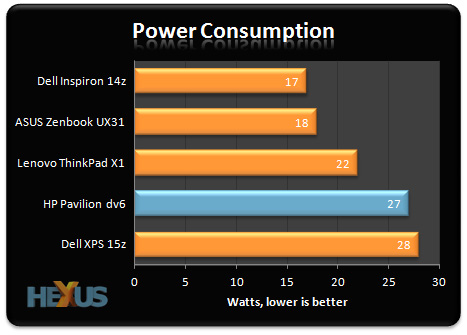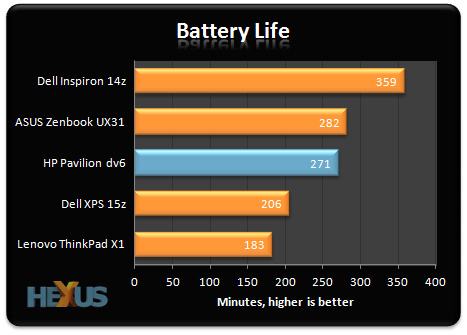Performance - Part 2
GPU Performance

Look at GPU performance, though, and the tables are turned. Using 3DMark to gauge the power of the respective GPUs, we can see that Intel's integrated HD 3000 is at the back of the pack, while the HP Pavilion dv6's combination of Radeon HD 6520G + Radeon HD 7470M scores slightly better than a Dell XPS 15z equipped with an NVIDIA GeForce GT 525M.
The AMD package delivers decent graphics performance, but what does this mean in the real world? All of the comparison laptops are able to handle high-def multimedia without kicking up a fuss, but the CrossFire graphics setup available to the Pavilion dv6 also provides basic gaming capabilities. With low-quality image settings at 1,280x720, the laptop was able to run Just Cause 2 at a playable 36.6 frames per second.
System Performance

PCMark 7 provides a better look at overall system performance by utilising varying workloads that stress the system's vital components - including the processor, graphics chip and storage device.
In this benchmark, CPU and storage performance really counts, and that explains why the HP Pavilion dv6 trails the pack. The CPU isn't as potent as the competition, and the 5,400RPM hard disk isn't geared for performance. Nonetheless, the system still feels nippy during everyday tasks, and it boots to the Windows desktop in under 40 seconds.
Power consumption and battery life

Power consumption is something of a double-whammy. The AMD A6-3430MX CPU isn't as quick as the Intel options, but the 45W chip does chew through more power.

But credit to HP, who by integrating a high-capacity six-cell battery enables the Pavilion to keep looping high-definition video for four-and-a-half hours in our battery rundown test.









